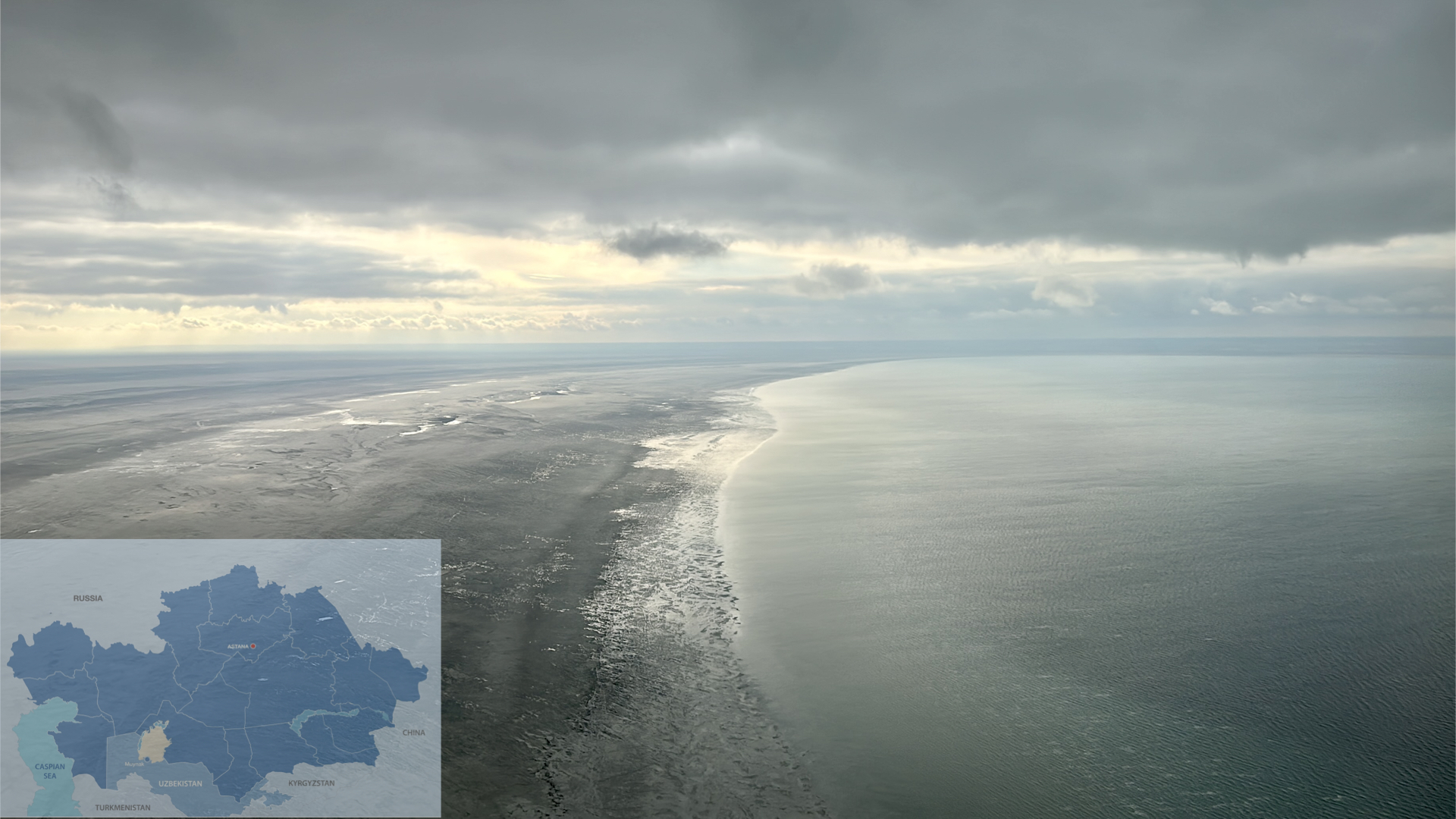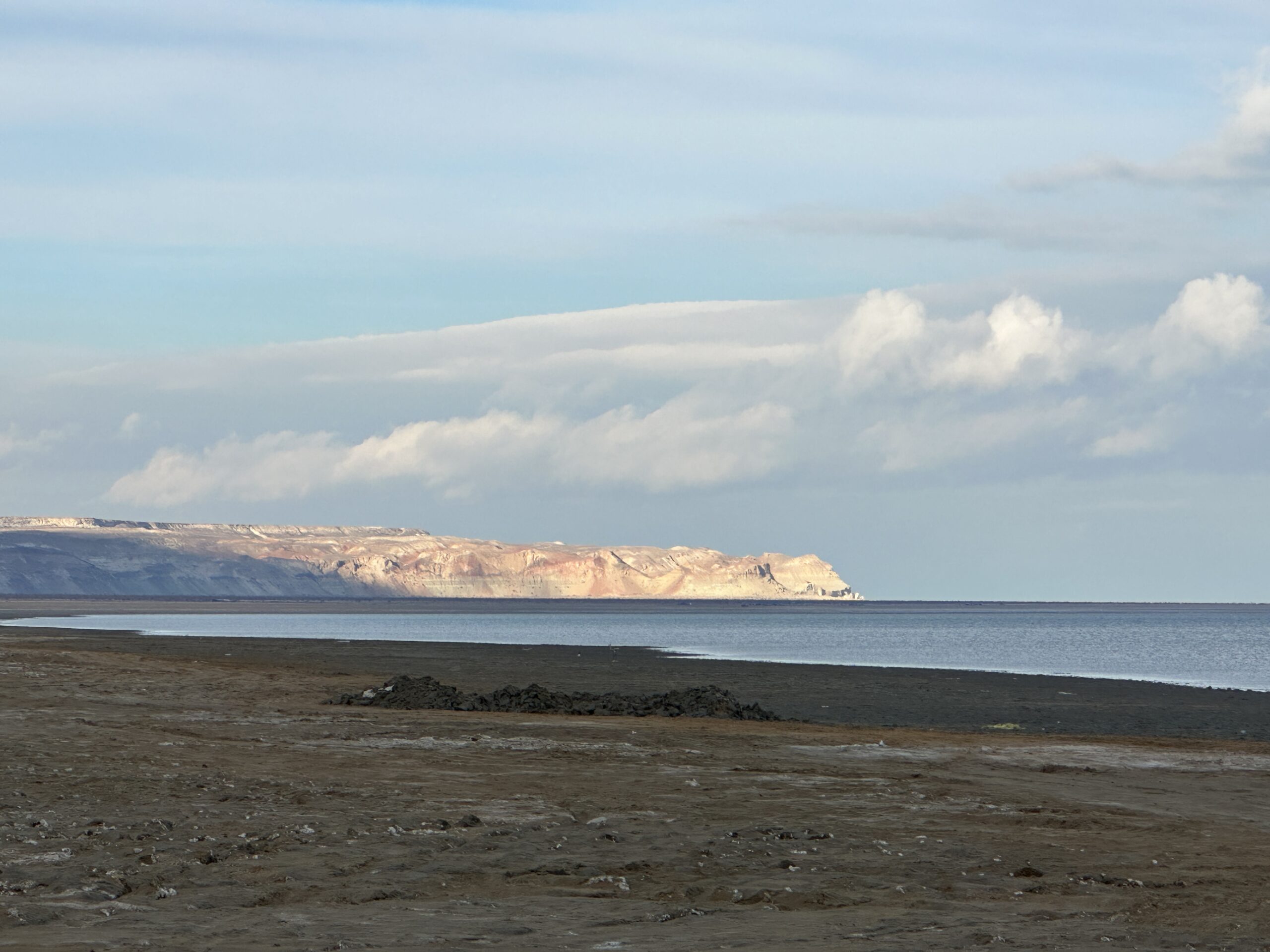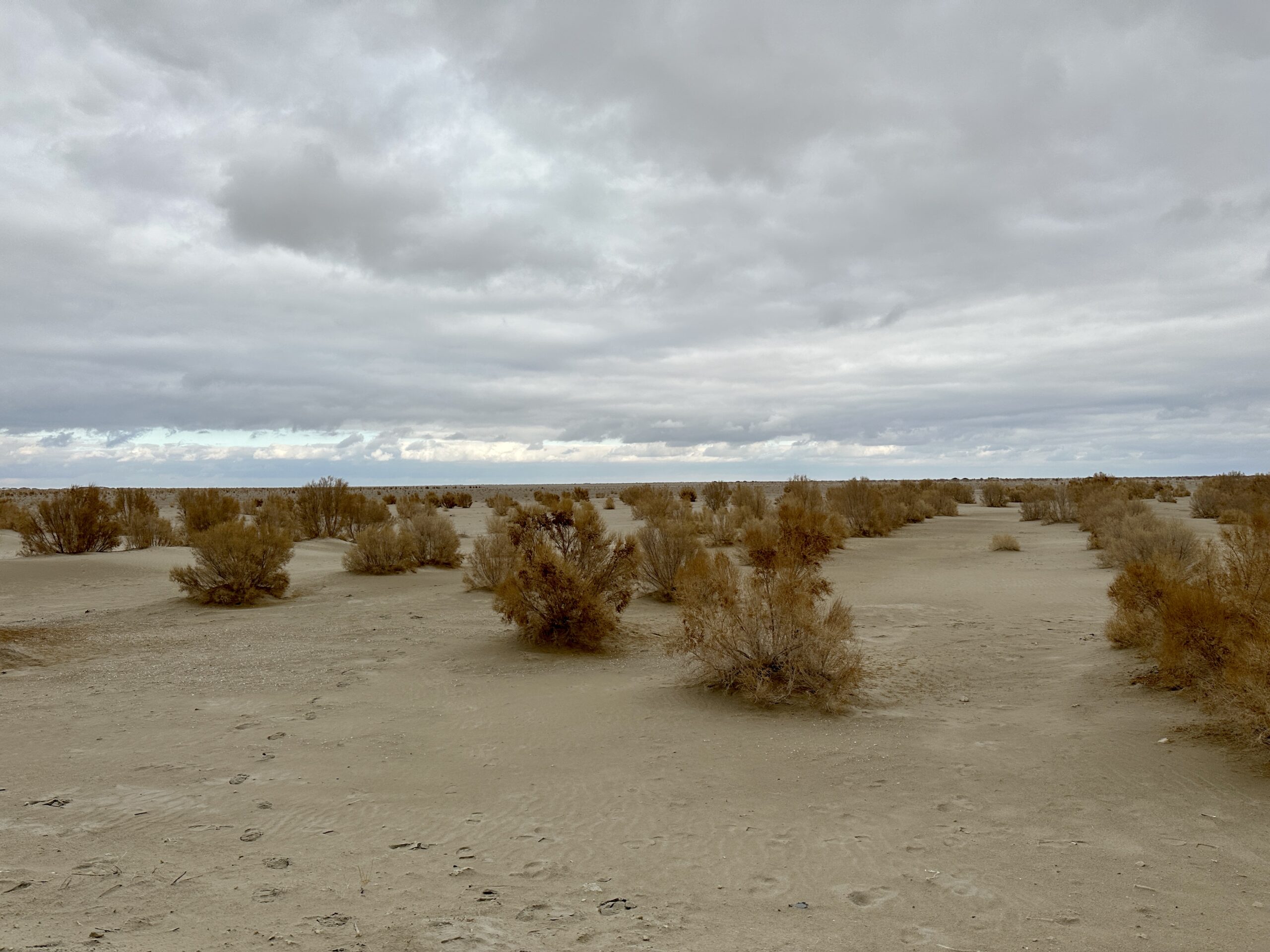MUYNAK, UZBEKISTAN – Uzbekistan’s ambitious saxaul plantation initiative is instilling optimism among scientists and residents of the dried-up Aral Sea basin that it will help to mitigate the increasing number of dust storms in Central Asia and avert related health risks.

A haunting meeting point of water’s retreat and the desolate shores. Photo credit: Aibarshyn Akhmetkali/The Astana Times. Click to see the map in full size. The map is designed by The Astana Times.
On a recent press trip to Muynak, once a thriving seaport of 25,000 people, organized by the Uzbek Ministry of Ecology, Environmental Protection, and Climate Change, a group of journalists, including The Astana Times correspondent, visited the sides of the western parts of the Aral Sea and Aralkum desert that has formed on the dried seabed.
The trip was organized as part of the 21st session of the United Nations Convention to Combat Desertification (UNCCD) Committee on the Review of the Implementation of the Convention (CRIC21) in Samarkand.
As the helicopter flew across a large, deserted territory, some gasped with shock, facing the magnitude of the Aral Sea crisis, which once used to be the fourth largest lake in the world.
History of the Aral Sea crisis
The roots of the Aral crisis go back to the Soviet period when the central government prioritized the economy over nature and decided to turn vast Uzbek lands into agricultural fields.

The shore of the remaining western part of the Aral Sea on Uzbekistan’s territory. Photo credit: Aibarshyn Akhmetkali/The Astana Times
As a result, in the 1960s, water from the Amu Darya and Syr Darya rivers was diverted into irrigation canals that fed cotton plantations across Uzbekistan.
“Cotton was a strategic raw material, especially for military purposes. So they implemented a plan to produce six million tons of cotton per year, which required huge volumes of water for cotton plantations,” said Aziz Abdukhakimov, the Uzbek Minister of Ecology, Environmental Protection and Climate Change.

Executive Secretary of the United Nations Convention to Combat Desertification (UNCCD) Ibrahim Thiaw (L) and Uzbek Minister of Ecology, Environmental Protection, and Climate Change Aziz Abdukhakimov (second left) listened to the presentation by academician Zinoviy Novitsky (R) on the implementation of saxaul project. Photo credit: Aibarshyn Akhmetkali/The Astana Times
The Amu Darya ceased to flow in 1982. With almost no water coming in, the Aral Sea retreated rapidly, and what remained of it became saltier and so poisonous that it could no longer support fish or wildlife on its shores. As the sea shrank to 10% of its original size, the exposed sea bed turned into one of the largest deserts in Central Asia.
“Not a single large meeting in the United Nations (UN) or other organizations passes without mentioning the Aral Sea problem. This is not accidental. History has never known such a thing – that a whole water body disappeared in one generation. The Aral Sea fed people, gave them jobs. Now it is dried up and gone,” said Zinoviy Novitsky, academician and doctor of agricultural sciences.

Amidst the transformed shores of the Aral Sea, locals embrace change trying to develop tourism. People can swim in salty waters which can no longer sustain fish. Photo credit: Aibarshyn Akhmetkali/The Astana Times
The situation is not improving as the Amu Darya water is still used to maintain Uzbekistan’s agricultural sector.
“In Uzbekistan, we only have the western part [of the sea] and it is drying up because there is no replenishment. The water from the Amu Darya and Syr Darya rivers is transferred to the dam, which is then used to irrigate agricultural land,” said Novitsky.
Water scarcity, amplified by climate change and the shrinking glaciers in the mountains of Turkmenistan and the Kyrgyz Republic that feed the two rivers, has hastened the Aral Sea’s decline.
Dust storms and health hazards
The dry climate and especially the continual winds have exposed the topsoil and led directly to the dust storms. Winds easily pick up the salt-laden sand and spread it thousands of kilometers away. The drained seabed, now exceeding six million hectares and divided between Uzbekistan and Kazakhstan, is one of the regions in Central Asia hardest hit by dust storms.

The Astana Times correspondent Aibarshyn Akhmetkali on the windy Aral Sea basin during the press tour. Photo credit: The Astana Times
The receding shores of the Aral Sea could expose nearby communities to as much as 150 million tons of dust every year. The wind carries tons of particles, including a variety of poisonous pesticides and other harmful substances.
“Salt, dust and sand rise into the air, mix with clouds and are carried thousands of kilometers away. They eventually fall as salty rains and snow, causing land degradation, desertification and reduction of crop yields. The air saturated with fine salt dust, which people breathe, causes various diseases. Look at the wind today. It blows constantly here and all this goes into the air,” said Novitsky.

A helicopter carrying media representatives landed on the observation area in the middle of the dried-out Aral Sea bottom. Photo credit: Aibarshyn Akhmetkali/The Astana Times
For a long time, the Aral Sea decline has been regarded primarily as an environmental problem. Still, the health and social consequences of the disaster are issues that can no longer be ignored.
In May 2018, houses, cars and vegetation were suddenly covered with a white layer resembling a winter snowfall, but it was the remnants of the salt storm that grazed throats and scratched the eyes.
“The consequence of the Aral Sea crisis was evident in the dust storm on May 27, 2018, when cities in Uzbekistan, neighboring Turkmenistan, and Kazakhstan were completely covered with salt,” said Novitsky.
Scientists say that dust storms are the main cause of the dire health problems that include epidemic levels of tuberculosis, respiratory illnesses, kidney problems and high infant mortality.
The Uzbek government’s response
With the dream of restoring the sea to its original size largely abandoned, the governments now focus more on mitigating the consequences of the Aral disaster.

Over 1.73 million hectares of forest plantations, including saxaul, have been planted in the Aralkum desert since December 2018. Photo credit: Aibarshyn Akhmetkali/The Astana Times
In 2018, at the initiative of Uzbek President Shavkat Mirziyoyev, the local government signed the largest state program for the radical transformation of the Aral Sea region through large-scale reclamation works on the dried sea bed.
Novitsky pointed to various dust suppression projects they have undertaken in recent years, including planting saxaul, saltbush and tamarix to tamp the soil down and prevent its spread through dust storms.
“In order to stabilize this area, we first decided to create sand-storage channel cuts. We dug these sand-storage channels, filled them with sand and planted mainly saxaul,” he said.

Sand-storage channel cuts viewed from a helicopter. Photo credit: Aibarshyn Akhmetkali/The Astana Times
More than 1.73 million hectares of forest plantations have been planted in Aralkum since December 2018. “This work continues. We still have 500,000 hectares left to utilize within 5-6 years,” added Novitsky.
According to him, one 10-year-old shrub can hold up to two tons of sandy substrate.
“In the areas where the forest plantations have been planted, the blowing out of sands, dust and salt has already dropped by 50-60%,” said Novitsky.

A ray of sunshine over the dry bottom of the Aral Sea as a beacon of hope for all humanity. Photo credit: Aibarshyn Akhmetkali/The Astana Times
The planting of saxaul was a challenging endeavor, but scientists in Uzbekistan continued to work. One issue was preventing saxaul from dying once its roots reached the salty layer.
“In three years, they [saxaul sprouts] have turned yellow because the roots have reached the salt layer. We thought for a long time about how to save these 10,000 hectares of plantations. Knowing the biology of saxaul, we figured that the more sand is used, the more it can give lateral roots. Then we prepared reeds, installed reed guards along each row, accumulated sand, and in five years, our saxaul came to life,” said Novitsky.
The state has also started up a project to develop a habitat for bees.
“There’s also a plant called tamarix. A hectare of blooming tamarix can yield 50 kilograms of honey. We have to help it grow now. It’s a new area, but local people are interested and we will create two beekeeping farms,” Novitsky said.
Regional cooperation
In 2023, the International Fund for Saving the Aral Sea (IFAS) marked 30 years, established by Central Asian states. During the meeting of the council of heads of the IFAS Founding States in Dushanbe, Tajikistan, in September, the officials emphasized the importance of regional cooperation between Central Asia countries, especially in renegotiating water distribution.
Neighboring Kazakhstan has also been implementing forestation projects in the Aral seabed region along with the construction of a Kokaral dam built in 2005 to contain the waters of the Syr Darya River within a small Aral basin, also called North Aral.
The dam rehabilitated the situation in the Small Aral, with the water level rising by nearly 1.5 billion cubic meters in 2023 for the first time in many years.

